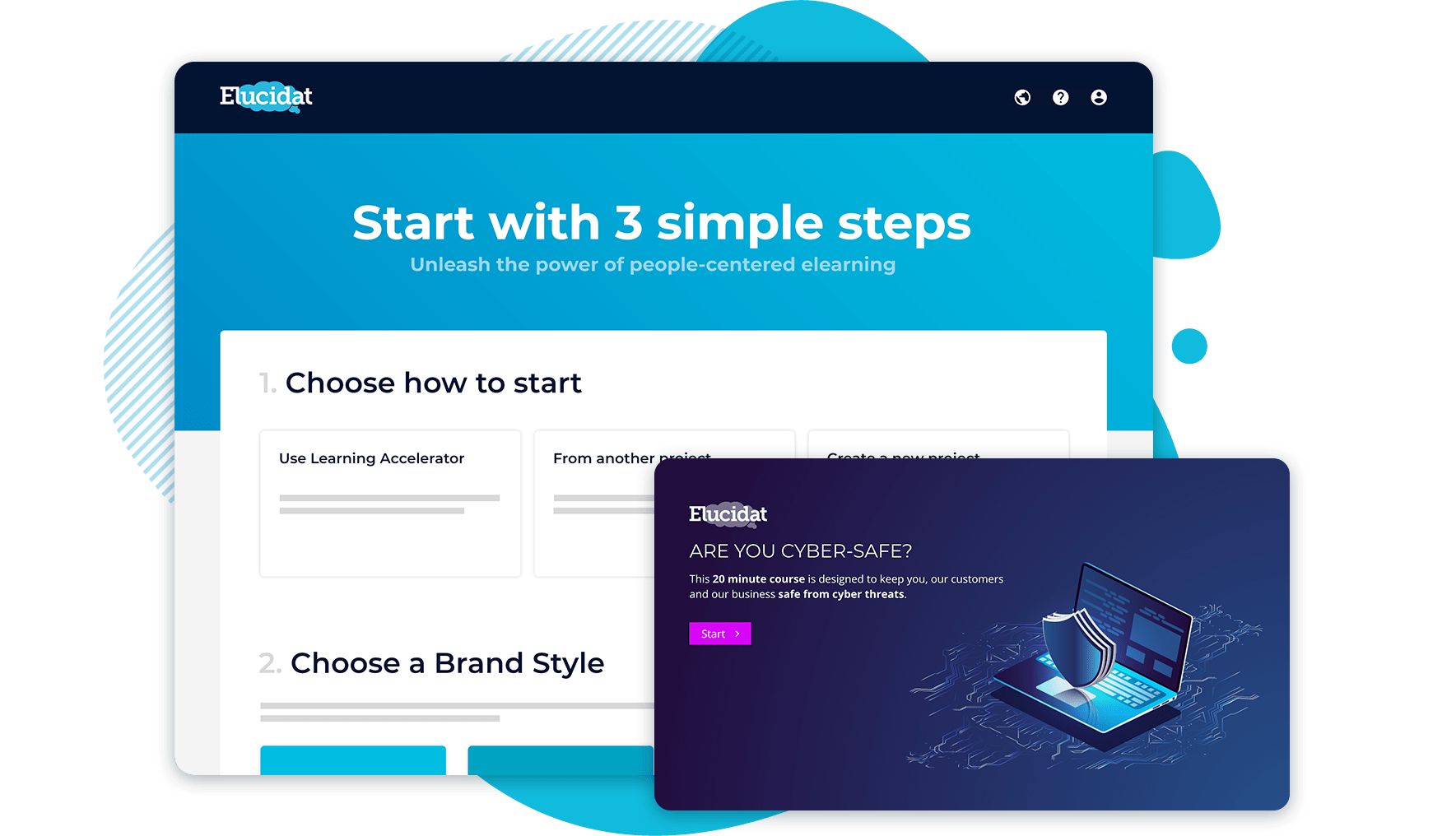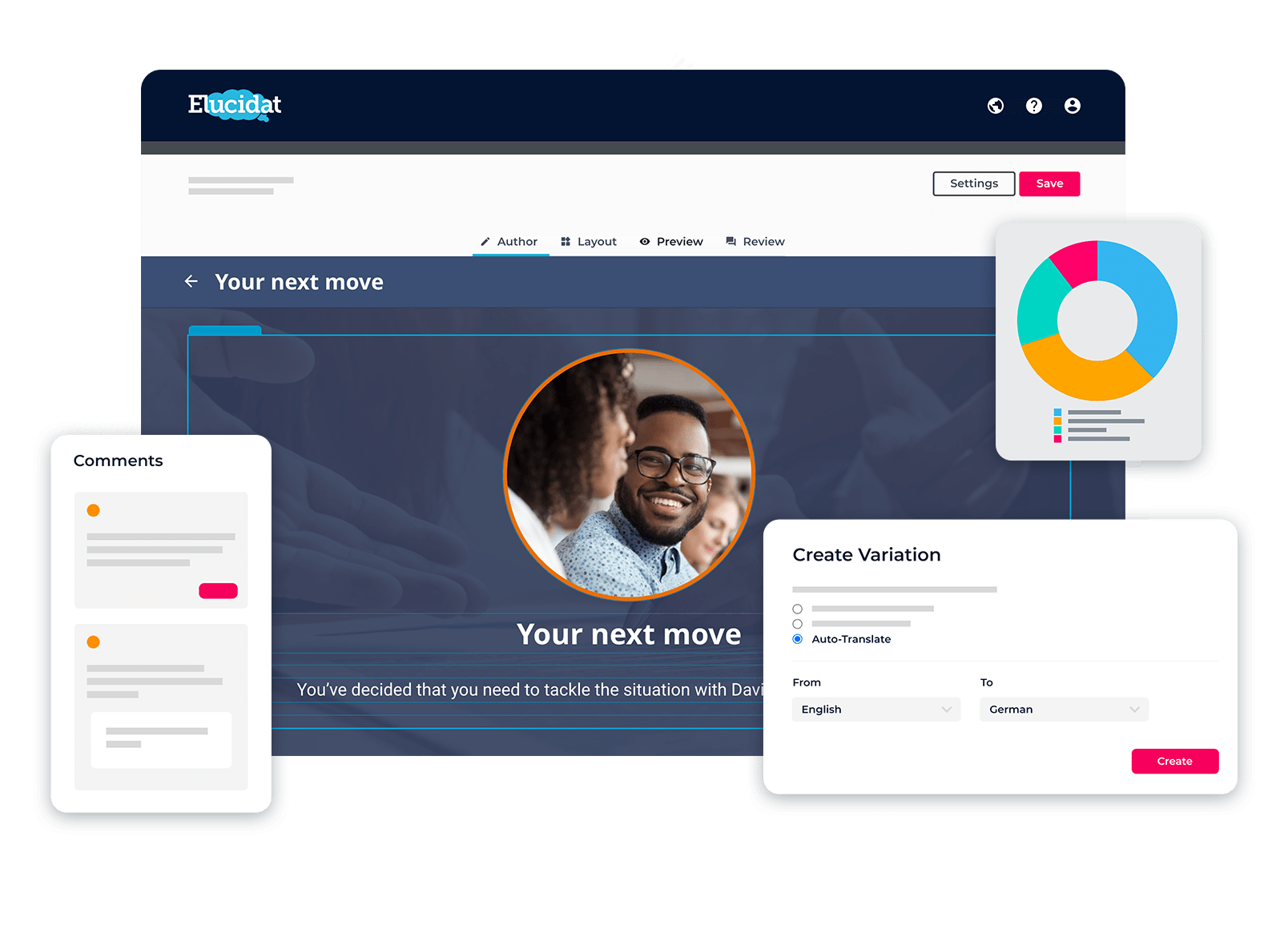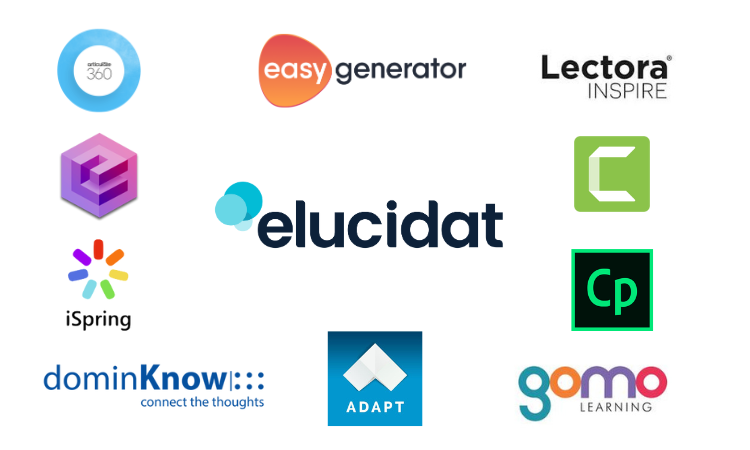6 benefits of cloud-based elearning
9 minute read
In a digital landscape dominated by cloud-computing, the embrace of cloud-based elearning marks a significant evolution in how we approach corporate learning and development. Moving beyond the limitations of traditional methods and scattered training materials, this shift harnesses the cloud’s vast potential to deliver a more accessible, efficient, and integrated learning experience. Ready to see how this transformation is reshaping professional training at its core? Let’s dive into the advantages of this pivotal change.

What is cloud-based elearning?
Cloud computing refers to using a network of central remote servers hosted online to store, manage, and process data.
What does this mean in terms of elearning? While desktop tools require a download and will run locally on each user’s device, their cloud-based counterparts are hosted online. This means that content is created, saved, managed, and delivered over the internet, through a central repository. And it’s all done in real-time. Read more about elearning best practices.
So, let’s explore the implications of this for enterprise organizations, and ask why they should be investing in cloud-based elearning.
The benefits of cloud-based e-learning
Below we have outlined six key benefits you can expect to see from cloud-based elearning.
1. Accessibility
Desktop applications run locally, which means you need adequate hard drive space and an installation to get started. Cloud-based elearning systems, on the other hand, enable you to access learning content from any location and device – all you need is an internet connection.
This means content creators, reviewers, and learners can easily switch between viewing a course on their laptop, home PC, and smartphone.
What’s more, new features and releases are automatically rolled out, without your users needing to do anything. That means no more tiresome downloads slowing down your devices.
2. Speed up production
Cloud-based elearning means more efficient collaboration – particularly when it comes to content creation. What does this look like in practice? For a start, all your organization’s digital content will sit within a single location, and as many users as required can go in and make changes to a particular online course.
Additionally, they can work simultaneously. So, while your subject matter experts (SMEs) input the text, your graphic artists can upload the images. And everything they do will be instantly fed through in real time. The result? Your L&D teams can expect shorter development timelines and avoid the inevitable headaches associated with version control.
Use of the cloud also means your organization’s images, logos, and videos can be saved online for easy access, so your content creators can browse, select, and drop files straight into a training course. From this central repository, it’s easy to make global updates. For instance, in Elucidat, if a company logo needs to be updated, only the original file needs replacing, and this change will be reflected wherever that asset sits.
3. Scalability
Cloud-based elearning also makes it easy to scale up your content; making it easier to manage on a larger scale compared to traditional, desktop-based elearning solutions.
Using a cloud-based elearning platform means you can quickly adapt to the changing needs of your organization. As your number of learners grows or decreases, the platform can scale up or down, ensuring that resources are efficiently used without overburdening your organization’s infrastructure.
Launching new elearning courses or updating existing content can be done quickly and efficiently on cloud platforms. This agility supports scalable learning strategies by enabling organizations to respond promptly to emerging training needs or changes in corporate strategy. What’s more, because everything is stored in the cloud, if a user’s device crashes whilst they’re developing a course, their efforts will have been saved.
4. Cost savings
Ultimately, cloud-based tools help keep costs down. They remove the reliance on computer hardware and infrastructure, making implementing your elearning strategy more cost-effective. Cloud-based elearning means you can increase your number of content creators, courses, and learners for less.
And that’s not to mention the costs saved through resourcing when you consider how much faster and more efficient it is to use a cloud-based tool.
5. Consistent content
The cloud enables you to establish and control your branding centrally. You can set your organization’s preferences for colors, fonts, and more, and save this as a pre-approved style for your team of content creators to use. Tools like Elucidat automatically update this style, applying the changes to consistent branding across all projects.
Some cloud-based elearning also offer content creators the chance to save their custom-made interactions, pages, and templates centrally, so they can be re-used by their peers. This helps speed up content development across the board, whilst ensuring a sense of continuity from one online course to the next.
6. Employee retention
When you embrace cloud-based elearning, your employees will benefit from more fulfilling learning experiences.
For a start, they can access learning materials on any device at the point of need. And because development timelines are much faster, this content will better reflect their ever-changing training requirements.
Many cloud-based tools also offer an auto-translate feature. This is a machine translation service that uses deep learning models, hosted in the cloud, to instantly translate your content into one of many languages. This means courses can easily be created in each learner’s required language, so no one is left behind.
The best part of the cloud is that it provides opportunities for learners to generate and share their own content. Tools like Elucidat enable social polls, where you can ask learners questions, collect their responses, and then show how their answers compare to their peers. The chance to connect learners in this way helps create engagement and boost learning retention.
The short of it? Better online learning experiences mean happy learners, and happy learners means better employee retention.
Examples of cloud-based learning management systems
Now we’ve looked at the benefits of cloud based elearning, let’s look at the top tools that will help you create, manage, and deliver impactful elearning content.
Elucidat
Elucidat is a multi-award-winning, cloud-based authoring tool that enables you to produce impactful elearning courses at scale.

Elucidat is a cloud-based tool, which means it allows multiple contributors to work on a course simultaneously, with all their changes instantly feeding through to a central version.
This is where Advanced User Management comes in handy, as it allows you to assign and customize the User Roles for each person in your Elucidat account. With full control over which users can edit your brand styles, delete projects, or upload assets, you can ensure everyone is working to their strengths, and open up your production without risk.
In terms of outputs, Elucidat offers a rich authoring toolkit, lots of room for customization, and options for gamification, personalized learning, and social polls. These key features help your authors create people-centered, engaging learning experiences. And all content is automatically optimized for mobile view, meaning it’s super easy to create great mobile learning experiences, without additional effort.

Once a course is ready for review, cloud-based hosting means you can invite any stakeholder to access a ‘review only’ version online. There’s no download or license required – all reviewers need to do is follow a link. From there, it’s super easy for them to share feedback amongst each other. Comments will be logged in situ against each element of the page, making it easy for your authors to interpret and action their change requests.
Having all your online courses stored centrally also makes it easier for novice authors to hit the ground running; Your L&D team can set up and share pre-approved company templates, packed with inline guidance. This makes it easy for newbies to start creating courses, whilst embedding quality and consistency into their content.
Elucidat is also one of the few tools to offer an Auto-Translate feature, instantly translating content into 75 languages. Combined with Variations Manager, rolling out and controlling multilingual projects becomes a breeze.
Easygenerator
Easygenerator is a cloud-based authoring tool, designed to simplify the creation of elearning courses.
With Easygenerator, you can jump into course development by using pre-built templates or the inbuilt PowerPoint converter. What’s more, it’s super easy to create quizzes, voiceover narration, and explainer videos.

Once a course has been built, cloud-based reviews will help streamline your workflows. However, because Easygenerator doesn’t host content in the cloud, updating your courses will involve several steps, making the tool less efficient than other, fully cloud-based offerings.
Articulate Rise
Rise 360, part of the Articulate 360 package, offers a simpler and more streamlined approach to authoring than its desktop sibling, Storyline 360.

It provides a straightforward authoring experience, whereby courses are built through the selection of pre-built blocks, which are automatically optimized for mobile view. Plus, like most cloud-based tools, multiple authors can work on the same course at the same time and make instant updates to content.
Reviews are smoothly executed via the Articulate Review feature, an online collaboration tool (and part of the Articulate 360 package) where contributors can collate feedback. This feedback is made in situ against each page element, so everyone can clearly see what changes need to be made.
Whilst the simplicity of Rise 360 is its biggest selling point, the tool is not so strong in terms of output. There’s little room for things like gamification and page layouts are very restricted. As a result, courses built in Rise 360 can start to feel a bit repetitive, which is intensified when working at scale.
The future of cloud-based elearning
So, now we’ve looked at the benefits of going cloud-based, as well as some of the products on the market, let’s consider what the future of cloud-based elearning might look like.
Use of AI
Cloud computing is key to the development of AI systems; Cloud vendors provide the resources and infrastructure to store and analyze vast amounts of data – exactly what’s needed for AI systems to operate. It’s no wonder then that as cloud computing has expanded, we have also seen huge developments in AI. But what does AI mean for the future of elearning?
We’ve already seen how some e-learning authoring tools are using AI to generate things like course summaries, knowledge checks, and translations. But these features aren’t fool-proof; Like any AI-generated content, the outputs will need reviewing and finessing by a human. But as the industry continues to refine these machine learning models, and they grow more intelligent, we can expect AI to deliver more advanced results, meaning authors can become more reliant on AI for more applications.
More collaborative learning
Our 2024 State of Digital Learning report found there’s increasing pressure on L&D to respond quicker to business needs and to do more with less. Organizations need new, more efficient ways of working, with an emphasis on collaboration, so they can harness the expertise of the right people to meet the right training needs.
As a result, enterprise organizations might expect to see smarter ways of capturing expertise, upskilling new authors, and rolling out content quickly. Social learning and user-generated content may continue to be explored as part of this, empowering learners to meet their own training needs.
Key takeaways
Cloud-based elearning will benefit everyone at your organization:
- It offers fast and efficient ways for your SMEs to create and manage digital content, rivalling traditional desktop approaches. This will become more apparent as we start to see AI playing a greater role in content generation.
- Learners can benefit from more accessible courses, delivered in their required language and on any device. And they can be sure this content is up to date and reflects their current training needs.
- Use of the cloud improves your data security while reducing the risks of data loss, unexpected costs, and technical difficulties, keeping your business leaders happy.
You can kickstart your transition to cloud-based elearning by investing in a cloud-based authoring tool, like Elucidat.
Getting started with cloud-based elearning with Elucidat
Elucidat is the ideal cloud-based elearning authoring tool for enterprise organizations, giving them the power to scale their content and create impact.



